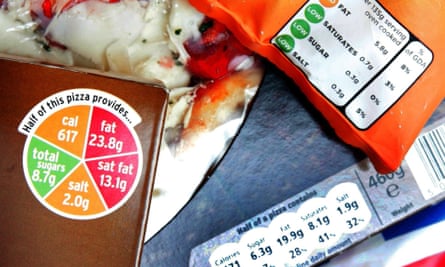The Royal Society for Public Health proposed last week in the British Medical Journal that food packaging should display symbols of “activity-equivalent” information: three little stick figures – on a chocolate bar wrapper, for example – shown running, cycling and swimming, with the number of minutes it would take the average person to burn off the bar’s calories by carrying out each activity.
They argue that this is a clearer and potentially more effective way of urging consumers to not only be more aware of the energy they consume and how that relates to their physical activity, but also to encourage them to be more physically active. The system we currently use: traffic lights displaying percentages in five categories – calories, fat, saturated fat, sugars and salt – is deemed too confusing by health experts, who say there is little evidence that they have changed behaviour.
We do need some innovative ideas around the obesity crisis we face because something is not working in our approach to food. A newly published Imperial College London study found that by 2025 nearly four in 10 people in Britain will be obese – making us the most overweight country on the continent. Meanwhile we have a shocking 1 million people currently being treated for eating disorders on the NHS. And yet when I read about this apparently simple and innocuous new labelling, my heart sank.
I had a decade-long battle against bulimia in my 20s, and from my perspective – as a healthy person now completely free from any kind of food obsession – I can see that this proposed system is actually part of the problem itself. It colludes with an unhealthy and haranguing white noise, an anxiety that prevails around food nowadays, in every direction: around what we eat and how we perceive what we eat, and therefore by extension how we perceive ourselves.
Not everybody would see it this way of course – those lucky enough never to have strayed into eating disorder territory or those who have never struggled with their weight, for example. But for the ones who are presumably supposed to benefit most from this system – who eat too much or not enough – what this labelling feeds into is a negative and guilt-ridden idea of compensation, which makes exercise sound like paying off a lack of willpower instead of the life-enhancing and life-changing pleasure it has the potential to be.
All this is within a broader landscape of anxiety and obsession over which foods are “good” and which are “bad” – and the pursuit of an impossible, pure, rule-driven way of eating that is the familiar turf of so many eating disordered people.
During my bulimic years, I was plagued by questions around food and what I should or shouldn’t, could or couldn’t eat. Was I addicted to sugar or high-fat foods? Were there dangerous “trigger” foods, “dangerous” foods that drove my cycles of binging and purging? Food exercise labels would, for me in those days, have been another guilt-inducing indication of what I viewed as my wanton lack of self-control when I fell, as I invariably did.
I attended an eating disorders unit and hoped that my dietitian, Carol Bowyer, who had spent a career working with people like me, would offer up a wealth of information on what I should and shouldn’t be eating, and reveal a magic cauldron of specific nutritional advice, pointing a finger at the bad stuff and the good stuff in some definitive, dichotomous way. But she didn’t do any of this.
Instead, Bowyer set out the simple advice: eat three balanced meals a day, aiming to include a carbohydrate, a fat and a protein in each meal, with a vegetable or fruit. That’s it. If you find you are hungry between meals, then have a snack. Don’t cut out any of the food groups. Did I want her to remind me of the different food groups? I didn’t – I already know what they are – it’s that old poster on the wall of the classroom or the doctor’s surgery with a fish, some potatoes spilling out of a bowl, a loaf of bread with some slices cut away from its end, some unidentified pulses, a bunch of vegetables. Surely it couldn’t be that straightforward.

Little did I know that this simple piece of advice is what I’d still be referring to 10 years later, as a mother deciding what to feed two small children and myself. In fact, it turns out that it was best advice I ever received on food and nutrition.
The irony is that I knew it already, most of us do, and the route to a healthier relationship with food is to cut out the shame, the guilt, the idea of compunction and compensation and come back to what we already know.
Once you abandon that obsessive, bullying preoccupation – both inside your head and in the general ubiquitous noise around food in our society – and get back to this simple message of the different food groups, a balanced plate, three meals a day, and plentiful enjoyable exercise, you are on the right track. And with this comes the strength, energy and resolve to put food in its place – in one small part of the varied and pleasurable fabric of our everyday life. You don’t need a label to tell you this.
